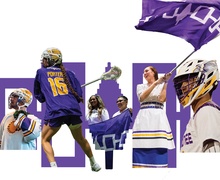Student organizations struggle to manage fiscal obstacles with new tier system
Meghan Hendricks | Photo Editor
There are four tiers in the student associations hierarchy of clubs, but it is difficult to move through them.
Get the latest Syracuse news delivered right to your inbox.
Subscribe to our newsletter here.
Senior Simone Bellot has yet to see a student organization experience a large increase in access to funding in her four years at Syracuse University.
Four “funding tiers” dictate how much money the over 300 registered student organizations at SU receive from the university. Each tier has a specific cap on the total amount of funds an organization can request per event.
Student leaders from various RSOs told The Daily Orange that organizations often feel disconnected from the funding allocation process, and that it can prevent new student organizations from gaining a foothold on campus and achieving their missions.
“I don’t think the tier system takes into consideration the nuances of organizations. I think it doesn’t necessarily consider the importance and what kinds of organizations need money,” she said. “The tier system isn’t considering the populations (student organizations) are serving.”
Organizations receive funding through the student activity fee, which SU’s Student Association distributes based on how organizations rank in the tier system, said Nyah Jones, SA’s comptroller. In order for an organization to move up a tier, they need to show that they have been successfully putting on events over a certain period of time.
As comptroller Jones is the only spokesperson for the student activities fee and votes on budgets for all student organizations in conjunction with the finance board. The tier process can be especially inaccessible due to language used in the point system and availability of information on how to receive more funding, she said.
But Jones has been trying to implement changes to ensure it serves student organizations to the best of its ability.
Iyanu Adeoba, the fiscal agent for Syracuse’s newly formed Black Student Union, said student organizations serve unique purposes as outlets for different identities.
“The different organizations on campus all represent different themes, which is why we have so many,” Adeoba said. “They all have their different purposes to help students come together and engage with each other.”
With less COVID-19 restrictions on campus, the rules and procedures student organizations have to abide by have changed, Jones said. Still, the system creates obstacles for new organizations who want to solidify their presence on campus, said Andrea Magdaleno, the fiscal agent for the newly-formed Mexican Student Association.

Stephanie Zaso | Design Editor
Mexsa has struggled to understand the various processes it has to go through to gain funding and find a way to solidify itself as a staple organization on campus, Magdaleno said.
The organization recently hosted their first big event for Día de los Muertos, and while the event went well, Magdaleno wishes they could’ve done more. The organization is currently ranked in tier one, and can receive up to $12,500.
“That went pretty good but it could have been better in a way,” Magdaleno said. “There’s so (many) things we wanted to do, but because of the (funding) restraint, we couldn’t.”
Before the current fiscal year, organizations needed six semesters of successful programming to apply to move up a tier, Jones said. Successful semesters and events were evaluated based on a point system, which Jones and the finance board dictated, she said.
While SA still has the point system in effect, it changed the eligibility requirements so organizations only need four nonconsecutive semesters of successful programming to move from tier one to two. They need five semesters to move from tier two to three and six semesters to move from three to four. SU has not yet published the application to change tiers.
Organizations are also struggling with each tier’s caps staying stagnant while inflation raises the cost of hosting an event every year, Bellot said.
Bellot is the president of the National Pan-Hellenic Council and vice-president and interim fiscal agent for the Caribbean Student Association. The NPHC is one of two registered student organizations that are classified as tier four organizations, and CSA is classified as tier three, Bellot said.
Many organizations have signature or “staple” events that they host regularly. For CSA, it’s Caribfest. But as a tier three organization, CSA has faced issues annually hosting the event, Bellot said.
“In 2015 this was a lot of money and you could get an artist and book Goldstein, but in 2022, that’s just not the case,” Bellot said. “For the amount of money, you just can’t throw the same caliber of event. And I don’t think that the tier system is accurately reflecting that.”
Though the only people allowed to present and comment on the financial codes were previously SA members, Jones put forward a bill last year that created a separate ad hoc committee for students outside of the association to change financial codes. Jones is also creating an application process for organizations to move up a tier.
Still, while it’s too early to see the effect of Jones’ changes, student organizations may not have the time to wait, Bellot said.
“Black Student Union is an extremely important organization to any Black student’s experience. The first thing you do when you come to college and you’re Black… (is) look for Black Student Union,” Bellot said. “They can’t do that (if) the E-board is stifled.”
Published on December 1, 2022 at 12:50 am






